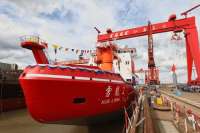
China's first domestically built icebreaker, the Xuelong 2, was launched from the Jiangnan Shipyard in Shanghai on Monday. The vessel is 122.5 meters long and 22.3 meters wide, with a displacement of 13,990 tons and a navigation capability of 20,000 nautical miles. Photo: VCG
China launched on Monday the 10th of September its first domestically built polar icebreaker, the Xuelong 2, a ship that has strong icebreaking capability and is expected to reach thick ice-covered polar regions including the North Pole, said Chinese experts.
The vessel was launched in the Jiangnan Shipyard in Shanghai on Monday, marking an important step in the shipbuilding process, Beijing-based newspaper Science and Technology Daily reported on Monday.
The launch of the Xuelong 2 means that the ship's overall structure, power system and other main equipment are completed, Zhang Xia, director of the Polar Strategy Center at the Polar Research Institute of China, told the Global Times on Monday.
After it finishes further interior building and sea trials, the ship will be delivered for use within the next year, Zhang said.
The vessel is 122.5 meters long and 22.3 meters wide, with a displacement of 13,990 tons and a navigation capability of 20,000 nautical miles. It also has two-direction ice breaking capabilities with both its bow and stern, the Xinhua News Agency reported.
The Xuelong 2 is considered a medium-sized icebreaker with a strong icebreaking capability comparable to the US icebreaker Healy, Zhang said, noting that it can reach most places in the Arctic and the Antarctic including the North Pole despite thick ice there.
"It is expected to participate in China's 10th Arctic expedition and 35th Antarctic expedition in 2019," Dong Yue, a research fellow at the Polar Research Institute of the Ocean University of China, told the Global Times on Monday.
Equipped with intelligent sensors and covered with wireless data connection. The ship has six state-of-the-art laboratories to be used to gather data and manage samples, it said.
With the launch of the Xuelong 2, China has gained the know-how on building an icebreaker and will not be dependent on foreign technologies in the future, Zhang noted.
Polar regions are closely related to the entire world in fields like global climate studies and environmental protection, Dong said.
He noted that it is China's responsibility to take part in polar affairs and create a community with a shared future.
Expeditions into the polar regions can not only boost China's science and technology capability, but also bring China commercial opportunities access to natural resources and tourism, Dong said.
